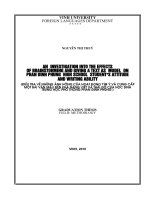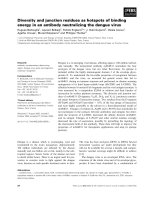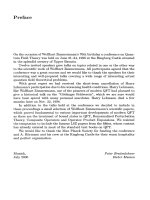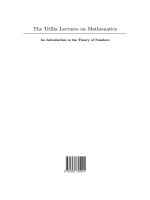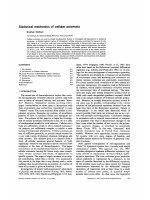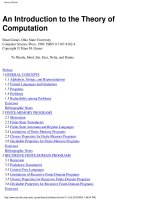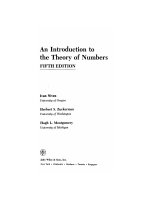- Trang chủ >>
- Khoa Học Tự Nhiên >>
- Vật lý
Quantum theory as an emergent phenomenon; the statistical mechanics of matrix models as the precursor of quantum field theory
Bạn đang xem bản rút gọn của tài liệu. Xem và tải ngay bản đầy đủ của tài liệu tại đây (1.32 MB, 238 trang )
QUANTUM THEORY AS AN
EMERGENT PHENOMENON
The Statistical Mechanics of Matrix Models
as the Precursor of Quantum Field Theory
Quantum mechanics is our most successful physical theory. However, it raises
conceptual issues that have perplexed physicists and philosophers of science for
decades. This book develops a new approach, based on the proposal that quantum
theory is not a complete, final theory, but is in fact an emergent phenomenon arising from a deeper level of dynamics. The dynamics at this deeper level is taken
to be an extension of classical dynamics to non-commuting matrix variables, with
cyclic permutation inside a trace used as the basic calculational tool. With plausible
assumptions, quantum theory is shown to emerge as the statistical thermodynamics of this underlying theory, with the canonical commutation–anticommutation
relations derived from a generalized equipartition theorem. Brownian motion corrections to this thermodynamics are argued to lead to state vector reduction and to
the probabilistic interpretation of quantum theory, making contact with recent phenomenological proposals for stochastic modifications to Schrăodinger dynamics.
S T E P H E N L. A D L E R received his Ph.D. degree in theoretical physics from
Princeton. He has been a Professor in the School of Natural Sciences at the Institute for Advanced Study since 1969, and from 1979 to 2003 held the State of
New Jersey Albert Einstein Professorship there.
Dr. Adler’s research has included seminal papers in current algebras, sum rules,
perturbation theory anomalies, and high energy neutrino processes. Dr. Adler has
also done important work on neutral current phenomenology, strong field electromagnetic processes, acceleration methods for Monte Carlo algorithms, induced
gravity, non-Abelian monopoles, and models for quark confinement. For nearly
twenty years he has been studying embeddings of standard quantum mechanics in
larger mathematical frameworks, with results described in this volume.
Dr. Adler is a member of the National Academy of Sciences, and is a Fellow of
the American Physical Society, the American Academy of Arts and Sciences, and
the American Association for the Advancement of Science. He received the J. J.
Sakurai Prize in particle phenomenology, awarded by the American Physical Society, in 1988, and the Dirac Prize and Medal awarded by the International Center
for Theoretical Physics in Trieste, in 1998.
www.pdfgrip.com
www.pdfgrip.com
QUANTUM THEORY AS AN EMERGENT
PHENOMENON
The Statistical Mechanics of Matrix Models
as the Precursor of Quantum Field Theory
STEPHEN L. ADLER
Institute for Advanced Study, Princeton
www.pdfgrip.com
Cambridge, New York, Melbourne, Madrid, Cape Town, Singapore, São Paulo
Cambridge University Press
The Edinburgh Building, Cambridge , UK
Published in the United States of America by Cambridge University Press, New York
www.cambridge.org
Information on this title: www.cambridge.org/9780521831949
© S. L. Adler 2004
This publication is in copyright. Subject to statutory exception and to the provision of
relevant collective licensing agreements, no reproduction of any part may take place
without the written permission of Cambridge University Press.
First published in print format 2004
-
-
---- eBook (NetLibrary)
--- eBook (NetLibrary)
-
-
---- hardback
--- hardback
Cambridge University Press has no responsibility for the persistence or accuracy of s
for external or third-party internet websites referred to in this publication, and does not
guarantee that any content on such websites is, or will remain, accurate or appropriate.
www.pdfgrip.com
To Sarah Brett-Smith, with love and admiration
www.pdfgrip.com
www.pdfgrip.com
Contents
Acknowledgements
Introduction and overview
1
The quantum measurement problem
2
Reinterpretations of quantum mechanical foundations
3
Motivations for believing that quantum mechanics
is incomplete
4
An overview of this book
5
Brief historical remarks on trace dynamics
1 Trace dynamics: the classical Lagrangian and Hamiltonian
dynamics of matrix models
1.1 Bosonic and fermionic matrices and the cyclic
trace identities
1.2 Derivative of a trace with respect to an operator
1.3 Lagrangian and Hamiltonian dynamics of matrix models
1.4 The generalized Poisson bracket, its properties,
and applications
1.5 Trace dynamics contrasted with unitary Heisenberg
picture dynamics
2 Additional generic conserved quantities
2.1 The trace “fermion number” N
2.2 The conserved operator C˜
2.3 Conserved quantities for continuum spacetime theories
2.4 An illustrative example: a Dirac fermion coupled
to a scalar Klein–Gordon field
2.5 Symmetries of conserved quantities under p F ↔ q F
3 Trace dynamics models with global supersymmetry
3.1 The Wess–Zumino model
3.2 The supersymmetric Yang–Mills model
vii
www.pdfgrip.com
page x
1
2
6
9
13
18
21
21
24
27
29
32
39
39
42
52
58
62
64
64
67
viii
4
5
6
7
Contents
3.3 The matrix model for M theory
3.4 Superspace considerations and remarks
Statistical mechanics of matrix models
4.1 The Liouville theorem
4.2 The canonical ensemble
4.3 The microcanonical ensemble
4.4 Gauge fixing in the partition function
4.5 Reduction of the Hilbert space modulo i eff
4.6 Global unitary fixing
The emergence of quantum field dynamics
5.1 The general Ward identity
5.2 Variation of the source terms
5.3 Approximations/assumptions leading to the emergence
of quantum theory
5.4 Restrictions on the underlying theory implied by further
Ward identities
5.5 Derivation of the Schrăodinger equation
5.6 Evasion of the KochenSpecker theorem and Bell
inequality arguments
Brownian motion corrections to Schrăodinger dynamics and the
emergence of the probability interpretation
6.1 Scenarios leading to the localization and the energy-driven
stochastic Schrăodinger equations
6.2 Proof of reduction with Born rule probabilities
6.3 Phenomenology of stochastic reduction – reduction
rate formulas
6.4 Phenomenology of energy-driven reduction
6.5 Phenomenology of reduction by continuous spontaneous
localization
Discussion and outlook
Appendices
Appendix A: Modifications in real and quaternionic
Hilbert space
Appendix B: Algebraic proof of the Jacobi identity for the
generalized Poisson bracket
Appendix C: Symplectic structures in trace dynamics
Appendix D: Gamma matrix identities for supersymmetric
trace dynamics models
Appendix E: Trace dynamics models with operator
gauge invariance
www.pdfgrip.com
70
72
75
76
81
88
93
100
106
117
119
124
128
139
147
151
156
157
170
174
175
185
190
193
194
194
198
201
204
Contents
Appendix F: Properties of Wightman functions needed for
reconstruction of local quantum field theory
Appendix G: BRST invariance transformation for global
unitary fixing
References
Index
www.pdfgrip.com
ix
206
208
212
220
Acknowledgements
I have many people to thank for their assistance in aspects of this work. The discovery by my thesis student Andrew Millard of the conservation of C˜ provided the
underpinning for the entire project. I am greatly indebted to him, and to my other
collaborators in the course of parts of this work, Gyan Bhanot, Dorje Brody, Todd
Brun, Larry Horwitz, Lane Hughston, Achim Kempf, Indrajit Mitra, John Weckel,
and Yong-Shi Wu. I am grateful to Jeeva Anandan, Angelo Bassi, Todd Brun, Lajos
Di´osi, Larry Horwitz, Lane Hughston, Gerald Goldin, Stanley Liu, Peter Morgan,
Philip Pearle, Artem Starodubtsev, and several anonymous publisher’s reviewers,
for many insightful comments on the first draft of this book. I am particularly indebted to Philip Pearle for detailed comments on the Introduction and Chapter 6, to
Larry Horwitz for a careful reading of the entire manuscript, and to Todd Brun and
Peter Morgan for remarks that led to the present form of Sec. 5.6. Finally, I wish
to thank my wife Sarah for her perceptive support throughout this long project.
I have benefited from conversations and/or email correspondence with a great
many others as well; a list (undoubtedly incomplete) includes: Philip Anderson,
John Bahcall, Vijay Balasubramanian, Lowell Brown, Jeremy Butterfield,
Tian-Yu Cao, Sudip Chakravarty, Freeman Dyson, Sheldon Goldstein, GianCarlo
Ghirardi, Siyuan Han, William Happer, James Hartle, Roman Jackiw, Abraham
Klein, John Klauder, Pawan Kumar, Joel Lebowitz, Anthony Leggett, James
Lukens, G. Mangano, Herbert Neuberger, Ian Percival, Michael Ramalis, SooJong Rey, Lee Smolin, Yuri Suhov, Leo Stodolsky, Terry Tao, Charles Thorn, Sam
Treiman, Walter Troost, Steven Weinberg, Frank Wilczek, David Wineland, and
Edward Witten.
Parts of this book are based on papers that were previously published in Nuclear
Physics B (Adler, 1994; Adler and Millard, 1996; Adler, 1997a) and in Physics
Letters B (Adler, 1997b; Adler and Horwitz, 2003), and I wish to thank Elsevier
Science, Ltd. for permission to use this material. I similarly wish to thank Institute
of Physics Publishing Ltd. for permission to use material originally published in
x
www.pdfgrip.com
Acknowledgements
xi
Journal of Physics A: Math. Gen. (Adler, 2002). Finally, I wish to acknowledge
the American Physical Society for use of material originally published in papers
appearing in the Journal of Mathematical Physics (Adler, Bhanot, and Weckel,
1994; Adler, 1998; Adler and Kempf, 1998; Adler and Horwitz, 1996, 2000) and
in Physical Review D (Adler and Wu, 1994; Adler, 2000, 2003a).
I also wish to acknowledge the hospitality of the Aspen Center for Physics,
and of both the Department of Applied Mathematics and Theoretical Physics and
Clare Hall at Cambridge University, as well as my home base at the Institute for
Advanced Study in Princeton. The Albert Einstein Professorship that I held while
writing this book was partially funded by the State of New Jersey, and my work
is also supported in part by the Department of Energy under Grant No. DE-FG0290ER40542.
www.pdfgrip.com
www.pdfgrip.com
Introduction and overview
Quantum mechanics is our most successful physical theory. It underlies our very
detailed understanding of atomic physics, chemistry, and nuclear physics, and the
many technologies to which physical systems in these regimes give rise. Additionally, relativistic quantum mechanics is the basis for the standard model of elementary particles, which very successfully gives a partial unification of the forces
operating at the atomic, nuclear, and subnuclear levels.
However, from its inception the probabilistic nature of quantum mechanics, and
the fact that “quantum measurements” in the orthodox formulation appear to require the intervention of non-quantum mechanical “classical systems,” have led to
speculations by many physicists, mathematicians, and philosophers of science that
quantum mechanics may be incomplete. Among the Founding Fathers of quantum
theory, Einstein and Schrăodinger were both of the opinion that quantum mechanics
is in some way unsatisfactory, and this view has been amplified in more recent profound work of John Bell, among others. In an opposing camp, many others in the
physics, mathematics, and philosophy communities have attempted to provide an
interpretational foundation in which quantum mechanics remains a complete and
self-contained system. Among the Founding Fathers, Bohr, Born, and Heisenberg
maintained that quantum mechanics is a complete system, and a number of recent proposals have been made to improve upon or to provide alternatives to their
“Copenhagen Interpretation.” The debate continues, and has spawned an enormous
literature. While it is beyond the scope of this book to give a detailed review of all
the proposals that have been made, to set the stage we give a brief discussion of the
measurement problem in Section 1, and we survey some of the current proposals
to revise the interpretational foundation of quantum mechanics in Section 2.
The rest of this book, however, is based on the premise that quantum mechanics is in fact not a complete system, but rather represents a very accurate asymptotic approximation to a deeper level of dynamics. Motivations for pursuing this
track are given in Section 3. The detailed proposal to be developed in this book
1
www.pdfgrip.com
2
Introduction and overview
is that quantum mechanics is not a complete theory, but rather is an emergent
phenomenon arising from the statistical mechanics of matrix models that have a
global unitary invariance. We use “emergent” here in the sense that it is used
in condensed matter, molecular dynamics, and complex systems theory, where
higher level phenomena (phonons, superconductivity, fluid mechanics, etc.) are
seen to arise or “emerge” as the expressions, in appropriate dynamical contexts,
of an underlying dynamics that at first glance shows little resemblance to these
phenomena. Initial ideas in this direction were developed by the author and collaborators in a number of papers dealing with the properties of what we termed
“generalized quantum dynamics” or, in the terminology that we shall use in this
exposition,“trace dynamics.” The purpose of this book is to give a comprehensive
review of this earlier work, with a number of significant additions and modifications that bring the project closer to its goal. We shall also relate our proposal
to a substantial body of literature on stochastic modifications of the Schrăodinger
equation, which we believe provides the low energy phenomenology, expressed
in terms of experimentally accessible observables, for the pre-quantum dynamics
that we develop here. A quick overview of what we intend to accomplish in the
subsequent chapters is given in Section 4, and some brief remarks on the history
of this project are given in Section 5.
Certain sections of this book are more technical in that they involve some knowledge of supersymmetry techniques and, although included for completeness, are
not essential to follow the main line of development; these are marked with an asterisk (*) in the section head. The exposition of the text is based on dynamical variables that are matrices in complex Hilbert space, but many of the ideas carry over
to a statistical dynamics of matrix models in real or quaternionic Hilbert space, as
sketched in Appendix A. Discussions of other topics needed to keep our treatment
self-contained are given in further appendices, and our notational conventions are
reviewed in the introductory paragraphs preceding Appendix A.
1 The quantum measurement problem
Quantum mechanics works perfectly well in describing microscopic phenomena,
and even in describing phenomena in which many particles act coherently in one
or a small number of quantum states, as in Bose–Einstein condensates, superfluids,
and superconducting Josephson junctions. Conceptual problems arise only when
one tries to apply the rules of quantum mechanics simultaneously to a microscopic
system and to the macroscopic apparatus that is measuring the state of the microscopic system; this is the origin of the notorious “quantum measurement problem.” We shall give here a simplified, “bare bones” description of the measurement
www.pdfgrip.com
Introduction and overview
3
problem, taking as an example a variant of the familiar Stern–Gerlach experiment.
(For a selection of papers on the measurement problem, see the reprint volume
Wheeler and Zurek, 1983.)
Consider a source emitting spin-1/2 particles with polarized spins, so that all
particles have spin component up along the x axis; that is, the initial beam is in
a state with Sx = 1/2. (We shall see in a moment how this is accomplished in
practice.) The particles then go through an inhomogeneous magnetic field aligned
along the z axis, which splits the beam into two spatially displaced components,
corresponding to components of the beam with spin component Sz = 1/2 and
Sz = −1/2, as shown in Fig. 1a. The quantum mechanical description of what has
happened so far is simply the spin state decomposition (with appropriate phase
conventions)
1
|Sx = 1/2 = √ (|Sz = 1/2 + |Sz = −1/2 ).
2
(1a)
At this point no measurement has been made; if we pass the split beams through
a second inhomogeneous field with the direction of inhomogeneity reversed, as in
Fig. 1b, and devote great care to the isolation of the beams from environmental influences, the two components of the beam merge back into one and what emerges
from the combined apparatus is the original state |Sx = 1/2 . (An analysis of issues involved in achieving spin coherence, and further references, are given in
Sculley, Englert, and Schwinger, 1989.)
To make a measurement, one must intercept one or both beams with a macroscopic measuring apparatus that absorbs the beam and registers a count in some
form. When the measuring apparatus A intercepts both beams, we get the conventional Stern–Gerlach setup pictured in Fig. 1c. This is described, in the von
Neumann (1932) model of measurement, by the evolution of the initial state
|Sx = 1/2 |Ainitial into a state in which the measured system and the apparatus
are entangled
1
√ (|Sz = 1/2 |A+ + |Sz = −1/2 |A− ),
2
(1b)
where |A+ is an apparatus state with a count shown on the upper counter and
none on the lower counter, while |A− is an apparatus state with a count shown on
the lower counter and none on the upper counter.
Once an apparatus intervenes in this way, two salient features become apparent.
The first is that it is impossible in practice to coherently recombine the total system consisting of beam and apparatus so as to regain the initial state |Sx = 1/2 .
This feature, that the two legs of the apparatus have decohered, can be understood
www.pdfgrip.com
4
Introduction and overview
within the framework of quantum mechanics: since the apparatus state is a complex, large system, reversing the joint evolution of beams and apparatus with sufficient accuracy to preserve interference requires an unachievable control over the
apparatus state. This is all the more so because in general the apparatus is in interaction with an external environment, into which phase coherence information is
rapidly dissipated, making a coherent recombination of the beams a practical impossibility. In density matrix language, the off-diagonal components of the density
matrix, when traced over the internal states of the apparatus and the environment,
rapidly vanish because of decoherence effects, leaving just diagonal components
that represent the probabilities for seeing the apparatus register an up or a down
Sz spin component. (For further discussions of decoherence theory, see Harris and
Stodolsky, 1981; Joos and Zeh, 1985; Zurek, 1991; and Joos, 1999.)
The second salient feature is that while there are definite probabilities for the apparatus to register a spin up or a spin down component, the outcome of any given
run of a particle through the apparatus cannot be predicted; part of the time it registers in the “up” counter, and part of the time it registers in the “down” counter. (In
the above example, the probabilities for registering “up” and “down” are both 1/2,
but for general orientations of the apparatus axis the probabilities will be sin2 θ/2
and cos2 θ/2, with θ the angle by which the inhomogeneous magnetic field is rotated with respect to the x axis.) This unpredictability of individual outcomes is
the origin of the quantum measurement problem. If we maintain that quantum mechanics should apply to both the particle passing through the apparatus and to the
measuring apparatus itself, then the final state at time t is described by a unitary
evolution U = exp(−i H t) applied to the initial state, and this describes a superposition as in Eq. (1b), not an either–or choice between outcomes that are described
by orthogonal states in Hilbert space. Since environmental decoherence effects still
involve a unitary evolution (in an enlarged Hilbert space describing the system, apparatus, and environment), they cannot account for this either–or choice observed
in the experimental outcomes. (See Adler, 2003b for a more detailed discussion of
this point, and for extensive literature references. For an opposing viewpoint, see
the review of Zurek, 2003.)
It is not necessary for the apparatus to intercept both beams for a measurement
problem to be apparent. Consider the apparatus illustrated in Fig. 1d, which intercepts only the “down” leg of the experiment. If the particles are gated into the
apparatus at definite time intervals, then a count on the “down” meter indicates that
a particle has been detected there, and subsequent downstream measurements in
the “up” leg will detect no particle there. If there is no count on the “down” meter
(i.e., a “down” meter anti-coincidence), then one can say with certainty that the
particle has passed through the “up” leg of the apparatus and is in a polarized state
|Sz = 1/2 ; this is how one produces a polarized beam. Decoherence accounts for
www.pdfgrip.com
Introduction and overview
a
5
c
d
b
Figure 1 Beam paths through variants of the Stern-Gerlach experiment. Where
the beams separate or recombine, there are magnetic fields that are not shown. a.
Spin up and down components are separated and continue to propagate. b. Spin
up and down components are separated, propagate, and then are coherently recombined. c. Spin up and down components are separated and each impinges on
a detector. d. Spin up and down components are separated, the down component
impinges on a detector, while the up component continues to propagate, producing a spin up polarized beam.
the fact that we cannot in practice reconstitute the original state |Sx = 1/2 , but it
cannot account for the stochastic pattern in which polarized particles emerge from
the “up” leg of our apparatus.
There are two conventional ways to try to avoid the measurement dilemma just
stated. The first is to assert that quantum mechanics has only a statistical interpretation, and should only be applied to describe the statistical properties of multiple
repetitions of an experiment, but not to any individual run. However, with the advent of our ability to trap individual particles for long periods, and to manipulate
their quantum states (e.g., the particle emerging from the “up” beam in Fig. 1d
could be run into a trap, and manipulated there), this interpretation of quantum mechanics becomes dubious. The second is to adopt the Copenhagen interpretation,
and to state by fiat that the unitary state vector evolution of quantum mechanics
does not apply to measurement situations. One then adds to the unitary evolution
postulate a second postulate, that of state vector reduction, which states that after a
measurement one sees a unit normalized state corresponding to the measurement
outcome | f , with a probability given by the Born rule P f = | f | |2 as applied
to the initial state | being measured.
While perfectly consistent for all experiments that have been performed to date,
the Copenhagen interpretation is at odds with the our belief that quantum mechanics should have universal applicability, and should describe the behavior of large
systems (such as a measuring apparatus) as well as microscopic ones. It also has
the bizarre feature of erecting a probabilistic theory, without an underlying sample
space of individual events, the coarse-grained behavior of which is described by the
www.pdfgrip.com
6
Introduction and overview
probabilities. In all other applications of probability theory, probabilities emerge
from the fact that one cannot observe, or chooses not to observe, individual details
which deterministically specify the outcomes. Quantum mechanics is unique in
that probabilities (or in some formulations, expectation values) are introduced as a
postulate, without emerging by some well-defined rule from an underlying sample
space of predictable individual events.
There are two logical possibilities for dealing with the problems just sketched.
The first is to maintain that quantum mechanics is exactly correct, but in need
of an improved conceptual foundation. One way to do this is to generalize the
Copenhagen interpretation, so as to eliminate the apparently arbitrary distinction
between “system” and “apparatus,” and to give a set of extended interpretive rules
with general applicability. This is the goal of the “consistent histories” approach
to quantum foundations. Another way to do this is to extend the kinematic rules of
quantum mechanics so as to give a concrete specification of a hidden sample space,
that is constructed so as to be in principle unobservable, which leads to Born rule
probabilities because full details of the sample space cannot be seen. This is what
is done in certain versions of the “many worlds” approach, and in the Bohmian
and Ax–Kochen approaches to quantum theory.
The second logical alternative is to consider the possibility that quantum mechanics is only a very accurate approximation to a deeper level of dynamics,
which in turn gives a unified understanding of both unitary Schrăodinger evolution and measurement dynamics. In this case the sample space that is created is
not constructed so as to be unobservable, and detectable deviations from quantum
mechanics become possible, leading to experimental constraints on the model parameters. As in any approach that proceeds by creating a sample space, there are
so-called “hidden variables,” and so important constraints imposed by no-go theorems coming from the work of Kochen and Specker (1967), Bell (1964, 1987),
and others, have to be observed.
In Section 2 immediately following, we shall briefly describe the approaches
that proceed from the assumption that quantum theory is exact but requires a new
conceptual foundation. In Section 3 we shall give motivations for considering the
possibility that quantum mechanics is in fact not an exact, final theory, which leads
into the main themes of this book.
2 Reinterpretations of quantum mechanical foundations
A number of approaches to the reinterpretation of quantum foundations, assuming that quantum theory is exact, have been explored in recent years. Our aim in
this section is to give a brief overview with entry points to the relevant literature,
without attempting either a detailed exposition or a critique.
www.pdfgrip.com
Introduction and overview
7
2.1 Histories
The histories approach is a generalization of the Copenhagen interpretation, that
replaces the imprecise notions of an “apparatus” and a “measurement” with more
precise concepts based on histories. The basic objects in this approach are timedependent projectors E k (tk ) associated with events (defined as properties at given
times) occurring in a history, and the probability of a history is then postulated to
be given by
p = Tr[E n (tn ) . . . E 1 (t1 )ρ E 1 (t1 ) . . . E n (tn )],
(2a)
with ρ the initial density matrix. This definition, supplemented by the notion of a
family of decohering histories, which describes mutually exclusive evolutions with
probabilities that sum to unity, can be argued to lead to all of the usual properties
of quantum mechanical probabilities. In this interpretation, state vector reduction
appears only as a Bayesian statistical rule for relating the density matrix after a
measurement to that before the measurement. Detailed accounts of the histories
approach can be found in the book of Griffiths (2002), the review and books
of Omn`es (1992, 1994, 1999), and the lectures of Hartle (1992). The histories
approach involves no enlargement of the basic mathematical apparatus of quantum
mechanics, and may still be relevant as a detailed description of quantum behavior
even if quantum mechanics turns out to be an approximation to a deeper level of
dynamics.
The three approaches that we discuss next all enlarge the mathematical structure
of quantum mechanics, so as to create a sample space which forms the basis for
the probabilistic interpretation. However, in all three cases the attributes that distinguish “individuals” in the sample space are not observable, so that there are no
predictions that differ from those of standard quantum mechanics. Because these
theories reproduce the results of quantum mechanics, it is evident that the assumptions of the Kochen and Specker (1967) and Bell (1964) no-go results are evaded.
In the Bell case, for example, this results from nonlocality in the construction of
the hidden sample space.
2.2 Bohmian mechanics
In Bohmian mechanics (Bohm, 1952), in addition to the Schrăodinger equation for
the N -body wave-function ψ(q1 , . . . , q N , t) that obeys
i h¯
N
h¯ 2 2
∂ψ
= −
∇qk + V
∂t
2m
k
k=1
www.pdfgrip.com
ψ,
(2b)
8
Introduction and overview
one enlarges the mathematical framework by introducing hidden “particles”
moving in configuration space with coordinates Q k and velocities
vk =
d Qk
h¯
Im∇ Q k log ψ(Q 1 , . . . , Q N , t).
=
dt
mk
(2c)
The state of the individual system is then specified by giving both the wave function and the coordinates Q k of the hidden particles. If the probability in configuration space is assumed to obey the Born rule p = |ψ|2 at some initial time, the
Bohmian equations then imply that this continues to be true at all subsequent times.
Arguments have been given that the Bohmian initial time probability postulate
follows from considerations of “typicality” of initial configurations. For detailed
expositions, see Bub (1997), Dăurr, Goldstein, and Zanghi (1992), and Dăurr,
Goldstein, Tumulka, and Zanghi (2003).
2.3 The AxKochen proposal
Ax and Kochen (1999) extend the mathematical framework of quantum theory to
encompass the “individual,” by identifying the ray with the quantum ensemble,
and the ray representative, i.e., the U (1) phase associated with a particular state
vector, with the individual. They then give a mathematical construction to specify
a unique physical state from knowledge of the toroid of phases. They argue that if
the a priori distribution of phases is assumed to be uniform, then their construction
implies that the probabilities of outcomes obey the usual Born rule.
2.4 Everett’s “many worlds” interpretation
In the “many worlds” interpretation introduced by Everett (1957), there is no state
vector reduction, but only Schrăodinger evolution of the entire universe. In this
interpretation, to describe N successive quantum measurements requires consideration of an N -fold tensor product wave function. The mathematical framework
can be enlarged to create a sample space by considering the space of all possible
such tensor products, and defining a suitable measure on this space. This procedure, given in the De Witt and Graham (1973) versions of many worlds, is the
basis for arguments obtaining the Born rule as the probability for the occurrence
of a particular outcome, that is, as the probability of finding oneself on a particular
branch of the universal wave function.
Since the reinterpretations of quantum theory sketched here all aim, by construction, to reproduce the entire body of predictions of nonrelativistic quantum
theory, they cannot be experimentally falsified (unless deviations from quantum
theory are eventually established). Thus, apart from issues of the extent to which
they can be generalized to encompass relativistic quantum field theory, the choice
www.pdfgrip.com
Introduction and overview
9
between them is somewhat a matter of taste. Rather than join in the already extensive literature debating their strengths and weaknesses, we shall proceed now to
consider an alternative possibility, that quantum mechanics is in fact not an exact,
complete structure.
3 Motivations for believing that quantum mechanics is incomplete
As surveyed in the preceding section, one approach to the quantum measurement
problem and associated “paradoxes” of quantum theory is to continue to assume
that quantum mechanics is exactly correct, and to attempt to supply it with a new
foundational interpretation. However, there is another logical possibility, which
is to suppose that quantum mechanics is not exactly correct, but represents an
extremely accurate approximation to a qualitatively different level of dynamics.
Since quantum theory is an extraordinarily successful physical theory, one can ask
why try to replace it with something else? We respond to this question by listing
a number of motivations for considering the possibility that quantum mechanics,
and quantum field theory, may require modification at a deeper level.
3.1 Historical precedent
The historical development of physics contains many examples of theories that
seemed to be exact in the context for which they were developed, only to require
modification when applied to a larger arena of phenomena. Newtonian mechanics
and Galilean relativity appeared to be exact in the context of planetary orbits, until
the need for their special and general relativistic extensions became apparent in the
early twentieth century. Classical predictability appeared to be exact in the context of classical mechanics, thermodynamics, and statistical mechanics, until confronted with the problems of the blackbody radiation spectrum and the discreteness
of spectral lines at the end of the nineteenth century. The Landau mean field theory
of critical phenomena was considered to be exact, until confronted with experimental data showing anomalous critical scaling, requiring the modern Kadanoff–
Fisher–Wilson theory of critical phenomena for its explanation. Given these
historical precedents, there seems to be no compelling reason to assume that quantum mechanics is immune to the general rule, that theories are only valid within a
given regime, and may require modification when extended beyond that regime.
3.2 The quantum measurement problem
As we have discussed in Section 1, the unitary evolution of standard quantum
mechanics does not describe what happens when measurements are made, but
www.pdfgrip.com
10
Introduction and overview
conventionally has to be supplemented by an additional postulate of nonunitary
state vector reduction when a “measurement” is performed by a “classical” apparatus. As many authors have stressed, an economical resolution of the measurement “paradoxes” would be achieved if one could find a more fundamental
underlying dynamics, from which the unitary evolution and the state vector reduction aspects of conventional quantum mechanics would emerge in a natural way
in the appropriate physical contexts. Such a resolution should show in a natural
way why quantum mechanics is probabilistic, by endowing it with an underlying
sample space, and should show how probabilities become actualities for individual
outcomes.
3.3 What is the origin of “canonical quantization”?
The standard approach to constructing a quantum field theory consists in first writing down the corresponding classical theory, and then “quantizing” it by reinterpreting the classical quantities as operators, and replacing the classical Poisson
brackets by −i/h¯ times the corresponding commutators or anticommutators. However, since quantum theory is more fundamental than classical theory, it seems
odd that one has to construct it by starting from the classical limit; the canonical
quantization approach has very much the flavor of an algorithm for inverting the
classical limit of quantum mechanics. Moreover, it is known through the theorem
of Groenewold and van Hove (for a recent review, see Giulini, 2003) that the Dirac
recipe of replacing Poisson brackets by commutators cannot consistently be applied to general polynomials in the canonical variables, but only to the restricted
class of second-order polynomials. Additionally, what is the origin of Planck’s
constant h¯ ? One might hope that in a new theory underlying quantum mechanics,
one would work with operators from the outset and proceed directly to operator
equations of motion without first starting from the classical limit, and that one
would also achieve an understanding of why there is a fundamental quantum of
action.
3.4 Infinities and nonlocality
An outstanding problem in quantum mechanics (or more specifically, in quantum
field theory) is the presence of infinities arising from the local structure of the
canonical commutation/anticommutation relations, and an outstanding puzzle in
quantum mechanics is the nonlocality seen, for example, in Einstein, Podolsky,
and Rosen (1935) type experiments. Both of these considerations motivate many
studies that have been made of quantum foundations, and in our view suggest that
www.pdfgrip.com
Introduction and overview
11
quantum mechanics may arise from a deeper level of physics that is substantially
nonlocal.
3.5 Unification of quantum theory with gravitation
There are a number of indications that conventional quantum field theory must
be modified in a profound fashion in order for it to be successfully combined
with gravitational physics. In generic curved spacetimes, it is not possible to give
a precise formulation of the particle production rate, nor is there necessarily a
well-defined concept of conserved energy. As is well known, when conventionally
quantized, general relativity leads to a non-renormalizable quantum field theory.
Another indication that quantum field theory must be modified when combined
with gravitational physics is provided by recent ideas on “holography,” which suggest that the association of degrees of freedom with volume subdivisions must
break down near the Planck energy. These problems are among the motivations
for replacing quantum field theory by a quantized theory of strings, but it is possible that modification of the rules of quantum theory will also be needed to give a
fully successful unification of the forces. In other words, in addition to exploring
“pre-geometrical” theories to explain quantum gravity, one may have to explore
“pre-quantum mechanical” theories as well.
3.6 The cosmological constant
Another indication that quantum mechanics may have to be modified to deal with
gravitational phenomena is provided by the problem of the cosmological constant.
In conventional quantum field theory it is very hard to understand why the observed cosmological constant is 120 orders of magnitude smaller than the natural
scale provided by the Planck energy. Either unbroken scale invariance or unbroken supersymmetry would forbid the appearance of a cosmological constant, but
they also forbid the appearance of a realistic particle mass spectrum, and so in
conventional quantum theory they do not provide a basis for solving the cosmological constant problem. The difficulty that arises here can be formulated as a
mismatch between the single constraint needed – a sum rule dictating the vanishing of the cosmological constant – and the infinite number of constraints arising
from having conserved operator scale and conformal transformation generators or
a conserved operator supercurrent. One possible way to resolve the cosmological
constant problem would be to find a deeper level of theory, in which the single
constraint needed to resolve the cosmological constant problem is matched, in a
naive counting sense, to the constraint arising from imposing scale invariance or
supersymmetry on that deeper level.
www.pdfgrip.com
12
Introduction and overview
3.7 A concrete proposal
Last, but not least, we have a concrete proposal for how to replace quantum mechanics by a deeper level of physical theory, that will have significant implications
for all of the issues just listed. Our proposal, already noted in the introductory paragraphs, is that quantum mechanics is an emergent phenomenon arising from the
statistical mechanics of matrix models with a global unitary invariance. To be more
specific now, our idea is to start from a classical dynamics in which the dynamical
variables are non-commutative matrices or operators. (We will use the terms matrix
and operator interchangeably throughout this book, and do not commit ourselves as
to whether they are finite N × N dimensional, or infinite dimensional as obtained
in the limit N → ∞.) Despite the non-commutativity, a sensible Lagrangian and
Hamiltonian dynamics is obtained by forming the Lagrangian and Hamiltonian
as traces of polynomials in the dynamical variables, and repeatedly using cyclic
permutation under the trace, which restricts the dynamical variables to be “trace
class,” and is the motivation for calling the resulting dynamics “trace dynamics.”
We further assume that the Lagrangian and Hamiltonian are constructed without
use of non-dynamical matrix coefficients, so that there is an invariance under simultaneous, identical unitary transformations of all of the dynamical variables, that
is, there is a global unitary invariance. We assume that the complicated dynamical equations resulting from this system rapidly reach statistical equilibrium, and
then show that with suitable approximations, the statistical thermodynamics of the
canonical ensemble for this system takes the form of quantum field theory. Specifically, the statistical thermodynamics of the underlying trace dynamics leads to the
usual canonical commutation/anticommutation algebra of quantum mechanics, as
well as the Heisenberg time evolution of operators, and these in turn, imply the
usual rules of Schrăodinger picture quantum mechanics. The requirements for the
underlying trace dynamics to yield quantum theory at the level of thermodynamics
are stringent, and include both the generation of a mass hierarchy and the existence of boson–fermion balance. We cannot at this point give the specific theory
that obeys all of the needed conditions; this is a topic for future work. There may
of course be no theory that satisfies our conditions, but our hope is that there will
be at least one underlying theory that fits into the general framework developed
here.
The proposal just sketched corresponds to the relations between classical mechanics, quantum mechanics, and the underlying “trace dynamics” theory that is
qualitatively pictured in Fig. 2. At the top level is classical mechanics, for which
the dynamical variables are all commutative. Classical dynamical variables are
usually represented as ordinary numbers, but they can also be represented as matrices in a Hilbert space, in which case they must all be taken as proportional to
www.pdfgrip.com
